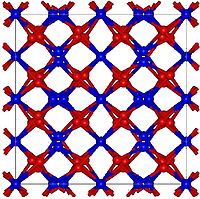Terbium(III) oxide
 |
|
| Names | |
|---|---|
|
IUPAC name
terbium(III) oxide
|
|
| Other names
terbium trioxide, terbia, terbium sesquioxide
|
|
| Identifiers | |
|
3D model (Jmol)
|
|
| ECHA InfoCard | 100.031.668 |
| EC Number | 234-849-5 |
|
PubChem CID
|
|
|
|
|
|
| Properties | |
| O3Tb2 | |
| Molar mass | 365.85 g·mol−1 |
| Appearance | white crystals |
| Density | 7.91 g/cm3 |
| Melting point | 2,410 °C (4,370 °F; 2,680 K) |
| 0.07834 cm3/mol | |
| Structure | |
| Cubic, cI80 | |
| Ia-3, No. 206 | |
| Hazards | |
|
EU classification (DSD)
|
not listed |
| Related compounds | |
|
Other anions
|
Terbium(III) chloride |
|
Other cations
|
Gadolinium(III) oxide Dysprosium(III) oxide |
|
Except where otherwise noted, data are given for materials in their standard state (at 25 °C [77 °F], 100 kPa).
|
|
|
|
|
| Infobox references | |
Terbium(III) oxide, also known as terbium sesquioxide, is a sesquioxide of the rare earth metal terbium, having chemical formula Tb
2O
3. It is a p-type semiconductor when doped with calcium, and may be prepared by the reduction of Tb
4O
7 in hydrogen at 1300 °C for 24 hours.
It is a p-type semiconductor.
It is a basic oxide and easily dissolved to dilute acids, and then almost colourless terbium salt is formed.
The crystal structure is cubic and the lattice constant is a = 1057 pm.
...
Wikipedia
